|
|
|
Sort Order |
|
|
|
Items / Page
|
|
|
|
|
|
|
| Srl | Item |
| 1 |
ID:
128862
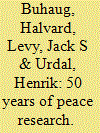

|
|
|
|
|
| Publication |
2014.
|
| Summary/Abstract |
Established in 1964, the Journal of Peace Research (JPR) celebrates 50 years. This anniversary special issue of the journal offers broad reviews of research areas that have been central both to the journal and to the field of peace and conflict research generally. An opening article co-authored by long-time editor Nils Petter Gleditsch offers a historical view on peace research and tracks trends in the use of 'peace' and 'violence' in titles of JPR across the first 49 volumes of the journal. Opening the review article section, two contributions address key thematic areas for the journal. Few if any subjects have attracted more attention in the study of international relations during the second half of JPR's first 50 years than the democratic peace, and in the extension of this subject, the broader debate about the liberal peace. Additional articles review the status and propose future developments in the study of war and its relationship with territory, ethnicity, ideology and natural resources. Another key historical topic associated with the journal concerns the economic cost of military conflict, while more recent research fields covered include terrorism and human rights, topics that have grown to become major JPR niches. Reflecting the methodological contributions by JPR, two articles focus on challenges of contemporary quantitative political analysis and progress in peace and conflict data collection. Finally, this special issue includes a review of research on international mediation in armed conflicts.
|
|
|
|
|
|
|
|
|
|
|
|
|
|
|
|
| 2 |
ID:
171064
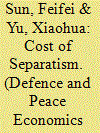

|
|
|
|
|
| Summary/Abstract |
The separatism and its related activities bring enormous economic costs to a society, which is however difficult to be estimated, because it involves both observable ethnic conflicts and unobservable psychological resistance. This paper investigates the economic consequences of the 1987–89 Tibetan Unrests with the synthetic control method and finds that per capita GDP in Tibet might be 27% higher for the period from 1988 to 2007 if the unrests had not happened. In addition, we implement several ‘placebo studies’ and assess the threats to the validity of causal inference to confirm the robustness of this study.
|
|
|
|
|
|
|
|
|
|
|
|
|
|
|
|
| 3 |
ID:
128870


|
|
|
|
|
| Publication |
2014.
|
| Summary/Abstract |
There is a large literature on the economic costs of military conflict, which uses a variety of methods including accounting procedures, statistical models and event studies of how stock markets respond to news of conflict. This literature is not only subject to all the criticisms directed against cost-benefit analysis but also introduces an element of arbitrariness by not considering benefits. This article uses four questions to structure a discussion of the calculation of conflict costs. The first concerns the purpose of the calculation: why is it being done? The second concerns the counterfactual: what comparison is being made? The third concerns the data: where do the numbers come from? The fourth concerns aggregation and valuation: how are the elements of costs (over outcomes, time and individuals) combined? The literature is often not clear on the answers to these questions, tending to take them for granted. However, the answers are crucial to the calculation and are not merely technical matters but rest on both the underlying objective of the calculation and fundamental philosophical and ethical judgements.
|
|
|
|
|
|
|
|
|
|
|
|
|
|
|
|
| 4 |
ID:
103373
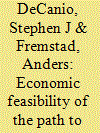

|
|
|
|
|
| Publication |
2011.
|
| Summary/Abstract |
The United States and other developed countries currently and historically have transferred considerable resources overseas to further their foreign policy objectives and to purchase oil and natural gas. These transfers are comparable in magnitude to estimates of the scale of the economic effort that would be required to create a world-wide energy system with zero carbon emissions by the middle of this century. Solar energy, the most abundant of the alternative energy supply sources, is currently the most expensive of the alternatives to fossil fuels but a substantial body of research and practical experience suggests that solar costs could fall to competitive levels with sufficient technological progress and increases in solar energy production and capacity.
|
|
|
|
|
|
|
|
|
|
|
|
|
|
|
|
| 5 |
ID:
178625
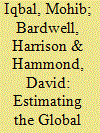

|
|
|
|
|
| Summary/Abstract |
This paper presents significant methodological improvements on Estimating the Global Costs of Violence. It also presents updated estimates of the global economic impact of violence at $14.8 trillion in 2017. This is equivalent to 12.4 per cent of global GDP or $1,988 per person. In the analysis, 163 countries are examined accounting for 99.5 per cent of the global population. The estimate is comprised of three domains which aggregate to yield a global estimate of the economic impact of violence. These three domains are the costs of interpersonal violence, the costs of collective violence and the expenditures on violence containment. A model of the economic cost of violence is established using a bottom-up accounting approach. This model follows the methodology of the 2018 Global Peace Index (GPI).
|
|
|
|
|
|
|
|
|
|
|
|
|
|
|
|
| 6 |
ID:
163520
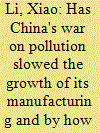

|
|
|
|
|
| Summary/Abstract |
We provide the first causal estimate of the aggregate effect of the 2013–2017 Clean Air Action, one of the largest and most recent environmental programs in China, on the growth of the manufacturing industry. Using a quasi-experimental approach, we find that the Clean Air Action significantly reduced the manufacturing output in the Beijing-Tianjin-Hebei region, which was subject to the most stringent air pollution regulation, by 6.7% during its first two years of implementation. The losses add up to 408.7 billion yuan (2013 price level), equal to 6.5% of the regional GDP in 2013. The action slowed the growth of manufacturing in Hebei and Tianjin by 9.6% and 5.9%, respectively. We find no evidence that it caused a significant reduction of manufacturing output in Beijing. The heterogeneous treatment effects can be explained by the difference in industrial structure between Beijing, Tianjin, and Hebei. Our analysis empirically suggests that the Clean Air Action helped drive the structural change of the Chinese economy by substantially suppressing “dirty” manufacturing sectors.
|
|
|
|
|
|
|
|
|
|
|
|
|
|
|
|
| 7 |
ID:
183738
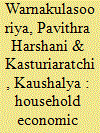

|
|
|
|
|
| Summary/Abstract |
Congenital heart disease is the commonest type of birth defect of which the estimated prevalence is around 8–12/1,000 worldwide. Caregivers of children with congenital heart diseases are easy victims of high economic burdens and economic instability.
|
|
|
|
|
|
|
|
|
|
|
|
|
|
|
|
| 8 |
ID:
132407
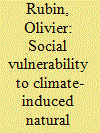

|
|
|
|
|
| Publication |
2014.
|
| Summary/Abstract |
This paper conducts an analysis of the socioeconomic determinants of Vietnam's cross-provincial variations in natural disaster vulnerability. The purpose is twofold: (i) to capture disaggregated vulnerability variations normally obscured by national statistics, thereby providing more nuanced insights into Vietnam's vulnerability to natural disasters; and (ii) to take advantage of the fact that the overall political system and key institutional structures to a large extent are constant across Vietnam's provinces, which makes the analysis a novel addition to the many disaster studies based on cross-national variations. The paper's analysis indicates that much of Vietnam's cross-provincial variations in natural disaster fatalities and economic costs can be explained by differences in key socioeconomic factors. High provincial rates of inequality, poverty and infant mortality, for instance, appear to drive up natural disaster fatalities. Local adaptation efforts should focus as much on these broader socioeconomic dimensions as they focus on the geophysical susceptibility to natural hazards of individual areas.
|
|
|
|
|
|
|
|
|
|
|
|
|
|
|
|
|
|
|
|
|